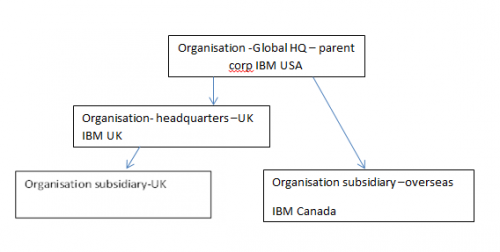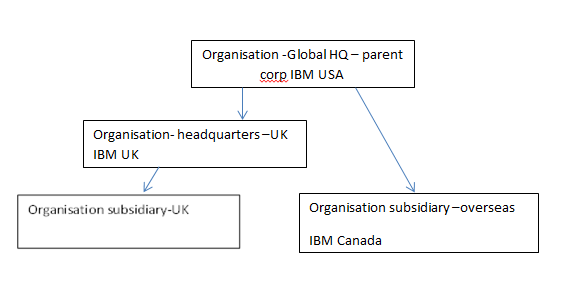How to record and structure Organisation records?
Options
I have a question regarding best practices for recording Organisations on RE. Say we have an Organisation which is IBM with a global head quarter in USA and then UK HQ and other subsidiaries. What is the best way to store all of this information on RE so that there is some structure to the organisation records. We have come up with the following structure.

Any advice, best practices and suggestions will be very helpful.

Any advice, best practices and suggestions will be very helpful.
Tagged:
0
Comments
-
Ali -
What's helpful is clarity on what you're trying to accomplish with these records.
Do you just need these relationships for information only, or do you need to perform some functions based on these relationships.- If you just need to structure these for informational purposes, then the relationships you've created between these records is probably enough.
- It looks like you can go to the top level organization record and see all the related organizations from there.
- If you structure things this way, you can't necessarily see the relationships across the organizations, only going up/down.
- ex: if you're on a subsidiary record you can't see other subsidiary records; you have to go up to the top level org to see the subsidiaries
- you can create additional relationships between all the records to solve this but it involves a lot of maintenance (depending on how many of them you have).
- Just like a family, do you create relationships from parents to all the children, and do you then do the extra step of creating relationships between all the child records? Or do you just know you have to go up to the parent record to see all the children.
- If you need to be able to group/grab these records for functional purposes, then you may need to create a more formal structure.
- In your diagram, you're showing parent, headquarters, subsidiary and locations for these records.
- You could think of these as attributes of these records.
- ex: So if you did create attributes for these then you could pull 'all headquarter orgs' or 'subsidiaries of a specific headquarter org located in these locations', etc.
- You could use these attributes as elements that you can mix/match to get your groupings.
- You can then create standard queries to get your groupings and make them commonly available (users can add to their Home page)
- ex: IBM USA and all subsidiaries
- IBM - All Headquarter organizations
- IBM - UK Headquarter and subsidiaries
- IBM - All subsidiaries only
- etc.....
0 - If you just need to structure these for informational purposes, then the relationships you've created between these records is probably enough.
-
Dear Gina
Thanks for your very helpful reply. I am working with Ali on the structure. I would be interested to know what you would suggest for Cons codes to back up the attributes? Our original plan was to use the Cons codes to denote the position of the organisation within the structure but I think this is overcomplex. It would be useful to know how you are using Cons codes for organisations?
best wishes
Seymour Kelly
Gina Gerhard:
Ali -
What's helpful is clarity on what you're trying to accomplish with these records.
Do you just need these relationships for information only, or do you need to perform some functions based on these relationships.- If you just need to structure these for informational purposes, then the relationships you've created between these records is probably enough.
- It looks like you can go to the top level organization record and see all the related organizations from there.
- If you structure things this way, you can't necessarily see the relationships across the organizations, only going up/down.
- ex: if you're on a subsidiary record you can't see other subsidiary records; you have to go up to the top level org to see the subsidiaries
- you can create additional relationships between all the records to solve this but it involves a lot of maintenance (depending on how many of them you have).
- Just like a family, do you create relationships from parents to all the children, and do you then do the extra step of creating relationships between all the child records? Or do you just know you have to go up to the parent record to see all the children.
- If you need to be able to group/grab these records for functional purposes, then you may need to create a more formal structure.
- In your diagram, you're showing parent, headquarters, subsidiary and locations for these records.
- You could think of these as attributes of these records.
- ex: So if you did create attributes for these then you could pull 'all headquarter orgs' or 'subsidiaries of a specific headquarter org located in these locations', etc.
- You could use these attributes as elements that you can mix/match to get your groupings.
- You can then create standard queries to get your groupings and make them commonly available (users can add to their Home page)
- ex: IBM USA and all subsidiaries
- IBM - All Headquarter organizations
- IBM - UK Headquarter and subsidiaries
- IBM - All subsidiaries only
- etc.....
0 - If you just need to structure these for informational purposes, then the relationships you've created between these records is probably enough.
-
Dear Gina
Sorry I seem to have replied to this in the wrong place. So I will try again
Thanks for your very helpful reply. I am working with Ali on the structure. I would be interested to know what you would suggest for Cons codes to back up the attributes? Our original plan was to use the Cons codes to denote the position of the organisation within the structure but I think this is overcomplex. It would be useful to know how you are using Cons codes for organisations?
best wishes
Seymour Kelly0 -
Seymour - Not sure if I can be all that helpful. We are a community foundation and dont' have complex needs around 'typing' organization records.
Our constituency codes (for organizations) are as follows:- Corporation/Business
- Estate
- Foundation-Community
- Foundation-DAF/Gift Fund
- Foundation-Private
- Government/Public Agency-NH (have these for other states as well)
- Nonprofit Organization
- School
- Trust-Deceased
- Trust-Living
- Parent Organization
- Subsidiary Organization
- Affiliated Organization
0
Categories
- All Categories
- Shannon parent
- shannon 2
- shannon 1
- 21 Advocacy DC Users Group
- 14 BBCRM PAG Discussions
- 89 High Education Program Advisory Group (HE PAG)
- 28 Luminate CRM DC Users Group
- 8 DC Luminate CRM Users Group
- Luminate PAG
- 5.9K Blackbaud Altru®
- 58 Blackbaud Award Management™ and Blackbaud Stewardship Management™
- 409 bbcon®
- 2K Blackbaud CRM™ and Blackbaud Internet Solutions™
- donorCentrics®
- 1.1K Blackbaud eTapestry®
- 2.8K Blackbaud Financial Edge NXT®
- 1.1K Blackbaud Grantmaking™
- 527 Education Management Solutions for Higher Education
- 1 JustGiving® from Blackbaud®
- 4.6K Education Management Solutions for K-12 Schools
- Blackbaud Luminate Online & Blackbaud TeamRaiser
- 16.4K Blackbaud Raiser's Edge NXT®
- 4.1K SKY Developer
- 547 ResearchPoint™
- 151 Blackbaud Tuition Management™
- 1 YourCause® from Blackbaud®
- 61 everydayhero
- 3 Campaign Ideas
- 58 General Discussion
- 115 Blackbaud ID
- 87 K-12 Blackbaud ID
- 6 Admin Console
- 949 Organizational Best Practices
- 353 The Tap (Just for Fun)
- 235 Blackbaud Community Feedback Forum
- 124 Ninja Secret Society
- 32 Blackbaud Raiser's Edge NXT® Receipting EAP
- 55 Admissions Event Management EAP
- 18 MobilePay Terminal + BBID Canada EAP
- 36 EAP for New Email Campaigns Experience in Blackbaud Luminate Online®
- 109 EAP for 360 Student Profile in Blackbaud Student Information System
- 41 EAP for Assessment Builder in Blackbaud Learning Management System™
- 9 Technical Preview for SKY API for Blackbaud CRM™ and Blackbaud Altru®
- 55 Community Advisory Group
- 46 Blackbaud Community Ideas
- 26 Blackbaud Community Challenges
- 7 Security Testing Forum
- 1.1K ARCHIVED FORUMS | Inactive and/or Completed EAPs
- 3 Blackbaud Staff Discussions
- 7.7K ARCHIVED FORUM CATEGORY [ID 304]
- 1 Blackbaud Partners Discussions
- 1 Blackbaud Giving Search™
- 35 EAP Student Assignment Details and Assignment Center
- 39 EAP Core - Roles and Tasks
- 59 Blackbaud Community All-Stars Discussions
- 20 Blackbaud Raiser's Edge NXT® Online Giving EAP
- Diocesan Blackbaud Raiser’s Edge NXT® User’s Group
- 2 Blackbaud Consultant’s Community
- 43 End of Term Grade Entry EAP
- 92 EAP for Query in Blackbaud Raiser's Edge NXT®
- 38 Standard Reports for Blackbaud Raiser's Edge NXT® EAP
- 12 Payments Assistant for Blackbaud Financial Edge NXT® EAP
- 6 Ask an All Star (Austen Brown)
- 8 Ask an All-Star Alex Wong (Blackbaud Raiser's Edge NXT®)
- 1 Ask an All-Star Alex Wong (Blackbaud Financial Edge NXT®)
- 6 Ask an All-Star (Christine Robertson)
- 21 Ask an Expert (Anthony Gallo)
- Blackbaud Francophone Group
- 22 Ask an Expert (David Springer)
- 4 Raiser's Edge NXT PowerUp Challenge #1 (Query)
- 6 Ask an All-Star Sunshine Reinken Watson and Carlene Johnson
- 4 Raiser's Edge NXT PowerUp Challenge: Events
- 14 Ask an All-Star (Elizabeth Johnson)
- 7 Ask an Expert (Stephen Churchill)
- 2025 ARCHIVED FORUM POSTS
- 322 ARCHIVED | Financial Edge® Tips and Tricks
- 164 ARCHIVED | Raiser's Edge® Blog
- 300 ARCHIVED | Raiser's Edge® Blog
- 441 ARCHIVED | Blackbaud Altru® Tips and Tricks
- 66 ARCHIVED | Blackbaud NetCommunity™ Blog
- 211 ARCHIVED | Blackbaud Target Analytics® Tips and Tricks
- 47 Blackbaud CRM Higher Ed Product Advisory Group (HE PAG)
- Luminate CRM DC Users Group
- 225 ARCHIVED | Blackbaud eTapestry® Tips and Tricks
- 1 Blackbaud eTapestry® Know How Blog
- 19 Blackbaud CRM Product Advisory Group (BBCRM PAG)
- 1 Blackbaud K-12 Education Solutions™ Blog
- 280 ARCHIVED | Mixed Community Announcements
- 3 ARCHIVED | Blackbaud Corporations™ & Blackbaud Foundations™ Hosting Status
- 1 npEngage
- 24 ARCHIVED | K-12 Announcements
- 15 ARCHIVED | FIMS Host*Net Hosting Status
- 23 ARCHIVED | Blackbaud Outcomes & Online Applications (IGAM) Hosting Status
- 22 ARCHIVED | Blackbaud DonorCentral Hosting Status
- 14 ARCHIVED | Blackbaud Grantmaking™ UK Hosting Status
- 117 ARCHIVED | Blackbaud CRM™ and Blackbaud Internet Solutions™ Announcements
- 50 Blackbaud NetCommunity™ Blog
- 169 ARCHIVED | Blackbaud Grantmaking™ Tips and Tricks
- Advocacy DC Users Group
- 718 Community News
- Blackbaud Altru® Hosting Status
- 104 ARCHIVED | Member Spotlight
- 145 ARCHIVED | Hosting Blog
- 149 JustGiving® from Blackbaud® Blog
- 97 ARCHIVED | bbcon® Blogs
- 19 ARCHIVED | Blackbaud Luminate CRM™ Announcements
- 161 Luminate Advocacy News
- 187 Organizational Best Practices Blog
- 67 everydayhero Blog
- 52 Blackbaud SKY® Reporting Announcements
- 17 ARCHIVED | Blackbaud SKY® Reporting for K-12 Announcements
- 3 Luminate Online Product Advisory Group (LO PAG)
- 81 ARCHIVED | JustGiving® from Blackbaud® Tips and Tricks
- 1 ARCHIVED | K-12 Conference Blog
- Blackbaud Church Management™ Announcements
- ARCHIVED | Blackbaud Award Management™ and Blackbaud Stewardship Management™ Announcements
- 1 Blackbaud Peer-to-Peer Fundraising™, Powered by JustGiving® Blogs
- 39 Tips, Tricks, and Timesavers!
- 56 Blackbaud Church Management™ Resources
- 154 Blackbaud Church Management™ Announcements
- 1 ARCHIVED | Blackbaud Church Management™ Tips and Tricks
- 11 ARCHIVED | Blackbaud Higher Education Solutions™ Announcements
- 7 ARCHIVED | Blackbaud Guided Fundraising™ Blog
- 2 Blackbaud Fundraiser Performance Management™ Blog
- 9 Foundations Events and Content
- 14 ARCHIVED | Blog Posts
- 2 ARCHIVED | Blackbaud FIMS™ Announcement and Tips
- 59 Blackbaud Partner Announcements
- 10 ARCHIVED | Blackbaud Impact Edge™ EAP Blogs
- 1 Community Help Blogs
- Diocesan Blackbaud Raiser’s Edge NXT® Users' Group
- Blackbaud Consultant’s Community
- Blackbaud Francophone Group
- 1 BLOG ARCHIVE CATEGORY
- Blackbaud Community™ Discussions
- 8.3K Blackbaud Luminate Online® & Blackbaud TeamRaiser® Discussions
- 5.7K Jobs Board




